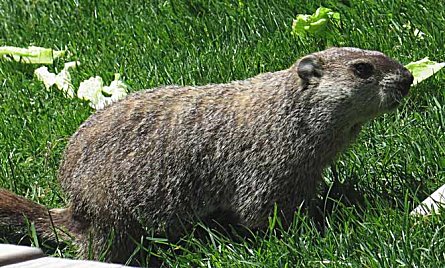Woodchucks - Hard to Find, Great to Hunt

It was 1962 when I first began to seriously hunt woodchuck. Back then, they were found everywhere. Today, populations have decreased for several reasons. One is the continuing development of woodlands and fields and the other is due to the increased numbers of coyotes and fishers who prey upon them whenever possible.
The timid woodchuck, also known as a “ground hog” or “whistle pig” is actually a member of the squirrel family and is generally the size of a small dog. It earned its nickname “whistle-pig” due to its tendency to produce a high-pitched whistle when frightened, which it will often times mix with both barking and chattering noises. Its eyes, ears and nose are strategically placed on the top of the head enabling it to check over the rim of its burrow for danger without exposing the rest of its body. Woodchucks can weigh anywhere from 6 ½ to 11 pounds, with the male species typically weighing in a bit more.

Common woodchuck
The body of the woodchuck is most often found to be between 18 and 26 inches long with its tail making up to a quarter of this length. Its bod y is covered with a primary layer of dark colored, short, wooly fur and a secondary, sparse layer of longer alternating yellow or red-brown colored hair tipped with white, giving the woodchuck a banded appearance. It has a stocky body fitted on top of what could be called “stubby” legs in proportion to its torso. Their feet are slightly flattened and tipped with curved claws that are well suited for digging.
Woodchucks are daytime foragers and are rarely ever seen outside of their den after sundown. During the summer months, woodchuck search for food in the morning and early evening hours. In the afternoon, they can be observed sprawled out sunning themselves in the midday sun. They are strict herbivores that are active in foraging during the daylight hours. Their food sources include: vegetables, grasses and legumes. In the spring, when green foliage is still scarce, woodchuck will eat bark, buds and twigs. Later in the season, they can be found standing on their hind legs to reach up and pull the top of a plant down to retrieve its foliage. When not foraging for food during the summer months, woodchuck will be seen sunning and grooming themselves.
Woodchuck prefer a habitat of pastures, loosely wooded fields and areas of dense shrubs. They prefer easy to dig loam and sandy loam soil to burrow in. Typically, its burrow opening will be found on the edge of a pasture or field with an opening approximately 10 to 12 inches in diameter and a large mound of dirt nearby. The tunnels they make can reach up to 45 feet long and up to 5 feet in depth. Many woodchuck often have a “drop hole” near the main burrow opening up to 2 vertical feet in depth that they will use for quick escapes from the surface. Each woodchuck burrow generally has up to four well hidden auxiliary entrances without the presence of dirt mounds. When hibernating, a woodchuck’s den will often be found under a stump, rocks, tree roots or some other such protection.
When hunting woodchuck, one has to be very observant. Having a pair of binoculars will be a big help. Also, remember that woodchuck spook easily. This means that you often won’t be able to get in close for a shot. A scope sighted rifle is an advantage. I’ve often had to take my shots as far away as 200 yards. If you come across some interesting looking fields that could be good possibilities, seek out the land-owner and ask his or her permission to hunt. You may have to just sit and observe the acreage for awhile until a woodchuck is spotted. If you see one and it sees you and disappears down a hole, you may have a long wait for it to come back up and it may not come up where it went down.
Believe it or not, the woodchuck is a tasty animal to eat, especially in a stew recipe. The
meat is dark. The younger chucks are much better than the mature ones. The meat from mature woodchucks tend to be extremely tough and strong flavored. Game care includes the immediate skinning and dressing (be sure to remove the three small pea-sized scent glands on the inside of the front legs) , sectioning and soaking all parts in a vinegar/saltwater mixture for four to five hours (½ cup vinegar, ¼ cup of salt per gallon of water). After soaking, remove the meat, dump the water and replace it with plain water plus ¼ cup of baking soda per gallon and soak the meat for an additional ½ to ¾ hours. Finally, take each piece of meat and rinse it well under running water, then pat dry with a paper towel.
Numerous recipes for woodchuck can be found on the internet by going to
www.google.com and then typing in woodchuck recipes. Also, their fur can be used for fly-tying. They are an interesting animal to seek and are certainly a challenge to hunt.

Bob Harris can be
reached via e-mail at:
outwriter2@aol.com
Past
Columns by Bob Harris
>>>
About
Bob Harris
>>>
DISCLAIMER: The opinions
expressed by Mr. Harris are not necessarily those of the
Goffstown Residents Association or its members
Copyright©2009 Goffstown Residents Association. All Rights Reserved. |





